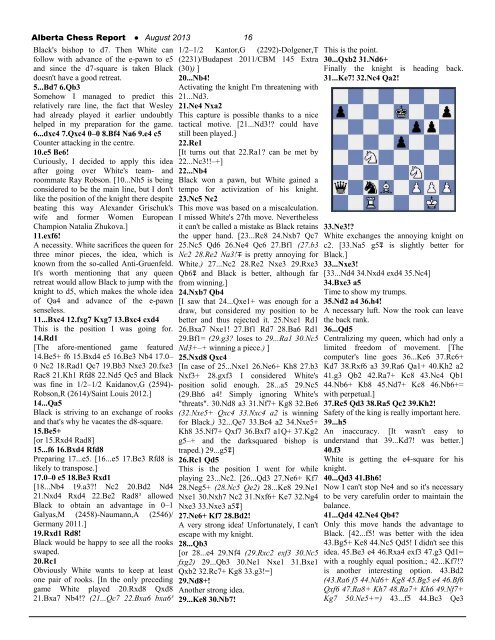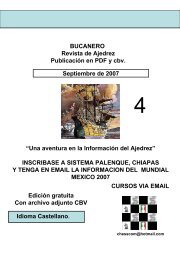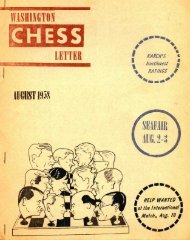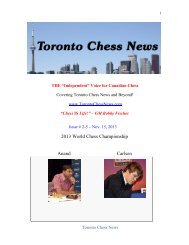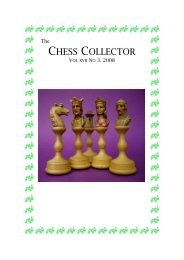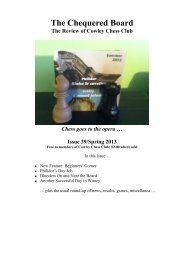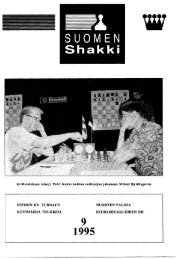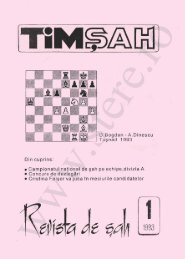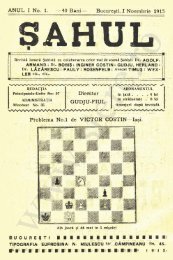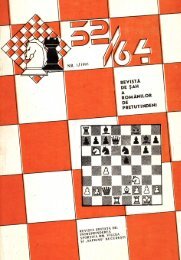Alberta Chess Report
El ajedrez es un juego, considerado un deporte, entre dos personas, cada una de las cuales dispone de 16 piezas móviles que se colocan sobre un tablero dividido en 64 escaques. En su versión de competición está considerado como un deporte.
El ajedrez es un juego, considerado un deporte, entre dos personas, cada una de las cuales dispone de 16 piezas móviles que se colocan sobre un tablero dividido en 64 escaques. En su versión de competición está considerado como un deporte.
You also want an ePaper? Increase the reach of your titles
YUMPU automatically turns print PDFs into web optimized ePapers that Google loves.
<strong>Alberta</strong> <strong>Chess</strong> <strong>Report</strong> ● August 2013 16<br />
Black's bishop to d7. Then White can<br />
follow with advance of the e-pawn to e5<br />
and since the d7-square is taken Black<br />
doesn't have a good retreat.<br />
5...Bd7 6.Qb3<br />
Somehow I managed to predict this<br />
relatively rare line, the fact that Wesley<br />
had already played it earlier undoubtly<br />
helped in my preparation for the game.<br />
6...dxc4 7.Qxc4 0–0 8.Bf4 Na6 9.e4 c5<br />
Counter attacking in the centre.<br />
10.e5 Be6!<br />
Curiously, I decided to apply this idea<br />
after going over White's team- and<br />
roommate Ray Robson. [10...Nh5 is being<br />
considered to be the main line, but I don't<br />
like the position of the knight there despite<br />
beating this way Alexander Grischuk's<br />
wife and former Women European<br />
Champion Natalia Zhukova.]<br />
11.exf6!<br />
A necessity. White sacrifices the queen for<br />
three minor pieces, the idea, which is<br />
known from the so-called Anti-Gruenfeld.<br />
It's worth mentioning that any queen<br />
retreat would allow Black to jump with the<br />
knight to d5, which makes the whole idea<br />
of Qa4 and advance of the e-pawn<br />
senseless.<br />
11...Bxc4 12.fxg7 Kxg7 13.Bxc4 cxd4<br />
This is the position I was going for.<br />
14.Rd1<br />
[The afore-mentioned game featured<br />
14.Be5+ f6 15.Bxd4 e5 16.Be3 Nb4 17.0–<br />
0 Nc2 18.Rad1 Qc7 19.Bb3 Nxe3 20.fxe3<br />
Rac8 21.Kh1 Rfd8 22.Nd5 Qc5 and Black<br />
was fine in 1/2–1/2 Kaidanov,G (2594)-<br />
Robson,R (2614)/Saint Louis 2012.]<br />
14...Qa5<br />
Black is striving to an exchange of rooks<br />
and that's why he vacates the d8-square.<br />
15.Be5+<br />
[or 15.Rxd4 Rad8]<br />
15...f6 16.Bxd4 Rfd8<br />
Preparing 17...e5. [16...e5 17.Be3 Rfd8 is<br />
likely to transpose.]<br />
17.0–0 e5 18.Be3 Rxd1<br />
[18...Nb4 19.a3?! Nc2 20.Bd2 Nd4<br />
21.Nxd4 Rxd4 22.Be2 Rad8³ allowed<br />
Black to obtain an advantage in 0–1<br />
Galyas,M (2458)-Naumann,A (2546)/<br />
Germany 2011.]<br />
19.Rxd1 Rd8!<br />
Black would be happy to see all the rooks<br />
swaped.<br />
20.Rc1<br />
Obviously White wants to keep at least<br />
one pair of rooks. [In the only preceding<br />
game White played 20.Rxd8 Qxd8<br />
21.Bxa7 Nb4!? (21...Qc7 22.Bxa6 bxa6³<br />
1/2–1/2 Kantor,G (2292)-Dolgener,T<br />
(2231)/Budapest 2011/CBM 145 Extra<br />
(30)) ]<br />
20...Nb4!<br />
Activating the knight I'm threatening with<br />
21...Nd3.<br />
21.Ne4 Nxa2<br />
This capture is possible thanks to a nice<br />
tactical motive. [21...Nd3!? could have<br />
still been played.]<br />
22.Re1<br />
[It turns out that 22.Ra1? can be met by<br />
22...Nc3!!–+]<br />
22...Nb4<br />
Black won a pawn, but White gained a<br />
tempo for activization of his knight.<br />
23.Nc5 Nc2<br />
This move was based on a miscalculation.<br />
I missed White's 27th move. Nevertheless<br />
it can't be called a mistake as Black retains<br />
the upper hand. [23...Rc8 24.Nxb7 Qc7<br />
25.Nc5 Qd6 26.Ne4 Qc6 27.Bf1 (27.b3<br />
Nc2 28.Re2 Na3!µ is pretty annoying for<br />
White.) 27...Nc2 28.Re2 Nxe3 29.Rxe3<br />
Qb6³ and Black is better, although far<br />
from winning.]<br />
24.Nxb7 Qb4<br />
[I saw that 24...Qxe1+ was enough for a<br />
draw, but considered my position to be<br />
better and thus rejected it. 25.Nxe1 Rd1<br />
26.Bxa7 Nxe1! 27.Bf1 Rd7 28.Ba6 Rd1<br />
29.Bf1= (29.g3? loses to 29...Ra1 30.Nc5<br />
Nd3+–+ winning a piece.) ]<br />
25.Nxd8 Qxc4<br />
[In case of 25...Nxe1 26.Ne6+ Kh8 27.b3<br />
Nxf3+ 28.gxf3 I considered White's<br />
position solid enough. 28...a5 29.Nc5<br />
(29.Bh6 a4! Simply ignoring White's<br />
"threats". 30.Nd8 a3 31.Nf7+ Kg8 32.Be6<br />
(32.Nxe5+ Qxc4 33.Nxc4 a2 is winning<br />
for Black.) 32...Qe7 33.Bc4 a2 34.Nxe5+<br />
Kh8 35.Nf7+ Qxf7 36.Bxf7 a1Q+ 37.Kg2<br />
g5–+ and the darksquared bishop is<br />
traped.) 29...g5³]<br />
26.Rc1 Qd5<br />
This is the position I went for while<br />
playing 23...Nc2. [26...Qd3 27.Ne6+ Kf7<br />
28.Neg5+ (28.Nc5 Qe2) 28...Ke8 29.Ne1<br />
Nxe1 30.Nxh7 Nc2 31.Nxf6+ Ke7 32.Ng4<br />
Nxe3 33.Nxe3 a5³]<br />
27.Ne6+ Kf7 28.Bd2!<br />
A very strong idea! Unfortunately, I can't<br />
escape with my knight.<br />
28...Qb3<br />
[or 28...e4 29.Nf4 (29.Rxc2 exf3 30.Nc5<br />
fxg2) 29...Qb3 30.Ne1 Nxe1 31.Bxe1<br />
Qxb2 32.Rc7+ Kg8 33.g3!=]<br />
29.Nd8+!<br />
Another strong idea.<br />
29...Ke8 30.Nb7!<br />
This is the point.<br />
30...Qxb2 31.Nd6+<br />
Finally the knight is heading back.<br />
31...Ke7! 32.Nc4 Qa2!<br />
33.Ne3!?<br />
White exchanges the annoying knight on<br />
c2. [33.Na5 g5³ is slightly better for<br />
Black.]<br />
33...Nxe3!<br />
[33...Nd4 34.Nxd4 exd4 35.Nc4]<br />
34.Bxe3 a5<br />
Time to show my trumps.<br />
35.Nd2 a4 36.h4!<br />
A necessary luft. Now the rook can leave<br />
the back rank.<br />
36...Qd5<br />
Centralizing my queen, which had only a<br />
limited freedom of movement. [The<br />
computer's line goes 36...Ke6 37.Rc6+<br />
Kd7 38.Rxf6 a3 39.Ra6 Qa1+ 40.Kh2 a2<br />
41.g3 Qb2 42.Ra7+ Kc8 43.Nc4 Qb1<br />
44.Nb6+ Kb8 45.Nd7+ Kc8 46.Nb6+=<br />
with perpetual.]<br />
37.Rc5 Qd3 38.Ra5 Qc2 39.Kh2!<br />
Safety of the king is really important here.<br />
39...h5<br />
An inaccuracy. [It wasn't easy to<br />
understand that 39...Kd7! was better.]<br />
40.f3<br />
White is getting the e4-square for his<br />
knight.<br />
40...Qd3 41.Bh6!<br />
Now I can't stop Ne4 and so it's necessary<br />
to be very carefulin order to maintain the<br />
balance.<br />
41...Qd4 42.Ne4 Qb4?<br />
Only this move hands the advantage to<br />
Black. [42...f5! was better with the idea<br />
43.Bg5+ Ke8 44.Nc5 Qd5! I didn't see this<br />
idea. 45.Be3 e4 46.Rxa4 exf3 47.g3 Qd1=<br />
with a roughly equal position.; 42...Kf7!?<br />
is another interesting option. 43.Bd2<br />
(43.Ra6 f5 44.Nd6+ Kg8 45.Bg5 e4 46.Bf6<br />
Qxf6 47.Ra8+ Kh7 48.Ra7+ Kh6 49.Nf7+<br />
Kg7 50.Ne5+=) 43...f5 44.Bc3 Qe3


